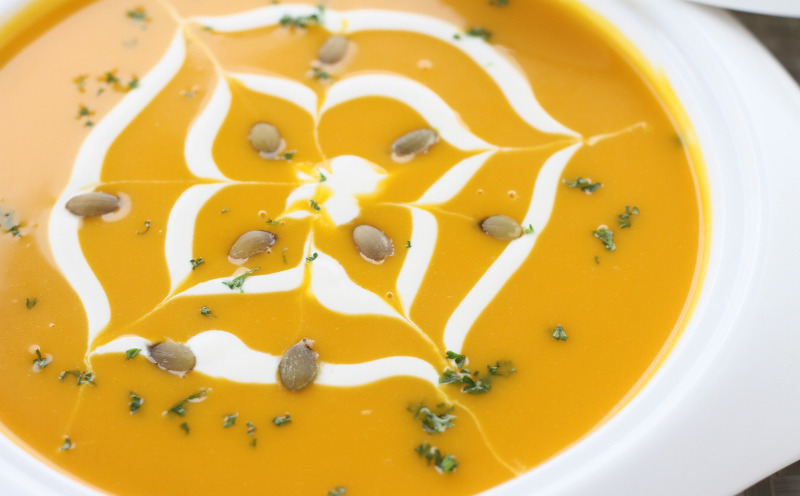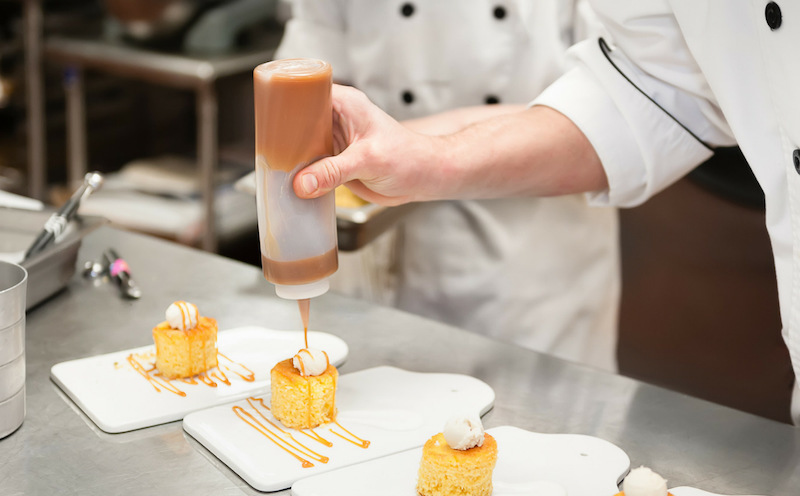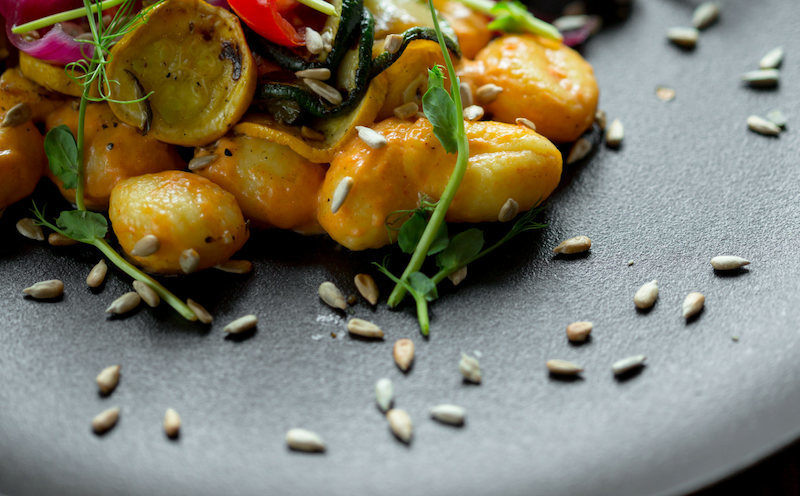
While you can easily toss a few sautéed sweet potatoes next to your cauliflower rice, a few tricks can transform it into a restaurant-quality dish. Seriously.
Chef Ryan Ross, winner of Food Network’s Chopped, shares her essential tips to playing your homemade dishes like a pro. Perfect for when you’re feeling particularly fancy.
Using Kitchen Tools
I’m not big on kitchen gadgets that serve only one purpose. Avocado pitters, egg slicers, and garlic presses are a waste of space in my tiny kitchen. However, there are a few plating tools that I keep on hand for making my dishes beautiful. Most of them you likely have on hand.
Toothpicks

Use toothpicks to create cool swirls and zig-zags through creams and sauces on your soups, smoothie bowls, and plates.
Spoons
You, of course, have spoons in your kitchen. But did you know you can use spoons to scoop a sauce or purée on a plate, and then drag the back of the spoon through it for an artful swipe effect?
Pastry or Biscuit Cutter
You can use your round pastry cutter as a boundary and mold to layer terrines, veggies, greens, and the like.
Squeeze Bottles

Speed-pouring bottles are great when you have lots of oils, drizzles, and sauces to dress up your dishes. They are lightweight, offer precision and keep all of your options looking uniform and tidy. Label them with a little masking tape and a sharpie.
Vegetable Peeler
Use this common household gadget to create long ribbons from your carrots and summer squash. They’re pretty in a salad to add a pop of color. You can even use them to shave chocolate into delicate curls over your cakes, cupcakes, and other pastries.
Mandolin
Mandolins are the quickest and most uniform way to get paper-thin sliced fruits and veggies. We’re talking gorgeous, paper-thin raw beets, radishes, rainbow carrots.
Spiralizer

Spiralizers let you transform raw fruits and veggies into fanciful “noodles” to pile on top of your dishes. Swap them in for a healthy twist on pasta or add spiralized beets and carrots to your salads for a colorful pop of color.
Precision Tongs / Tweezers
You can purchase long, culinary precision tongs, or designate a pair of drugstore tongs to your kitchen. These come in handy when stacking, adjusting and plating teeny items on your dish. I also use regular tweezers to remove the pin bones out of fish filets.
Choosing the Right Dishware
Natural, plain and nondescript dishware are a good place to start.
Opt for a white dish, and you’re automatically working with a high-contrast, natural background. It’s great for plating most foods; a plain white plate can make even drab-looking food pop.
When plating lighter and brighter foods, use darker hues like wood or a dark, stony gray for contrast.
If you’re feeling creative, there are plenty of unorthodox options to play with. There’s fine china, crazy patterns, earthen and stoneware, wood planks, ceramic, cast iron, and slate boards. There are hundreds of shapes, sizes, platters, plates and bowls to choose from!
The Rule of Thirds vs. Central Plating

If you look at your dish like a clock, start by imagining your dinner guest seated at the 6 o’clock when served. Now that you are oriented with your dish, you can easily decide and delegate what goes where.
When serving a dinner party, I often ask my front of house staff to serve according to the clock. I will say things like, “The radish should be at the 3 o’clock”.
Most classic plating guides will have you regard your dish in thirds. Plating your focal point, usually your protein, a touch off-center, in either outer third of your plate, is considered most attractive.
The same goes for plating in odd numbers, like seven carrot batons instead of eight, or three slices of duck instead of two, and so on.
Salads and other composed items are quite striking when piled high and central on the dish.
Use moist foods as a base and anchor for the star of your plate, usually the protein. You can then use other components of your dish to scatter and lean against the stack you have already created.
If you are plating centrally, like with a leafy tall salad, go for minimal landscape garnishing; a few straying micro greens or petals can be pleasant on the plate beyond your salad, or a simple extra swirl of infused oil on the plate.
Artful elements like dots, swirls and swipes create more of a landscape plating. Using the rule of thirds for your plate can help you decide how, when, and where your embellishments belong so your dish doesn’t get away from you.
Garnishes
Microgreens, baby arugula and fresh herbage are a great garnish on most things savory, and even those that are sweet. Mint, basil, fennel fronds, and sweeter herbs like anise and hyssop have a big place in the dessert-garnishing world.
Colorful garnishes certainly elevate your dish. Plates with beige and brown foods are drab and muted, but adding pops of bright green herbs, or edible flower petals, are an awesome way to stand out!
On the other hand, don’t be afraid to go monochromatic. Peruvian purple potatoes garnished with micro-greens, purple skinned radish, purple basil, or blue-hued cornflowers can create a stunning effect.
Texture

Top off your dishes with seeds, nuts, sprouts and palatable hearty spices, powders, herbs, and salts.
My favorites include:
- Hemp seeds
- Chia seeds
- Poppy seeds
- Sesame seeds
- Pink peppercorn
- Aleppo pepper
- Crushed nuts
- Dried lavender
- Dried calendula petals
Getting Creative
Every chef will have their own idea of what looks best, so use these tips as a guideline for the plating possibilities out there. Being creative sometimes means that you need to color outside of the lines, or find your own way and style.
Think about your fresh garnishes that may otherwise be scraps or compost that you naturally discard. These can be reinvented and used as a plating element.
These include:
- Herb stems, blended into a sauce or infused in an oil or salt
- Carrot top greens
- Fruit and vegetable skins (opt for organic)
- Chips, either fried or dehydrated, made from fruit and veggie scraps
Think outside of the box when preparing your garnishes – perhaps an applied method makes all the difference.
- Tie a knot in your chives
- Sear or grill your lemon wedge
- Fry your basil leaves
Use this guide as inspiration to start plating your food in artful ways at home. Apply these tips at your next dinner party or on a weeknight when you need to spice things up!
(Read This Next: The Expert’s Guide on How to Cook Mouth-Watering Vegetables)
